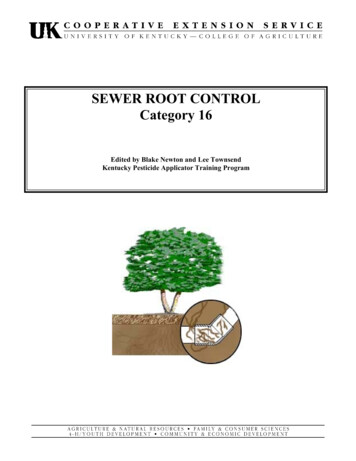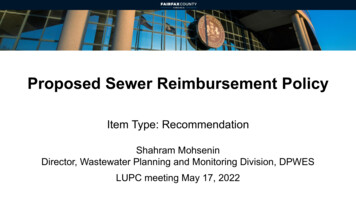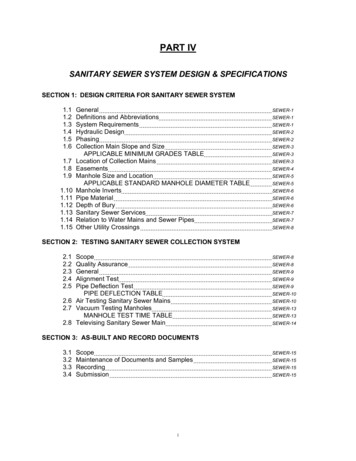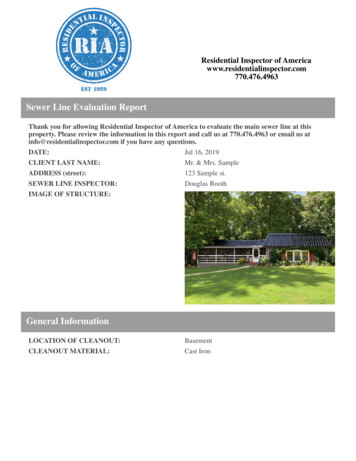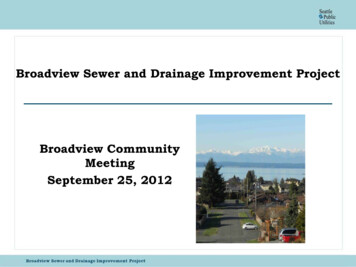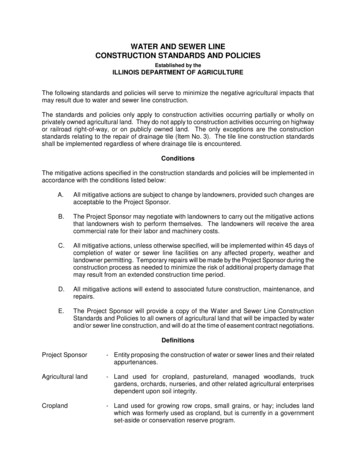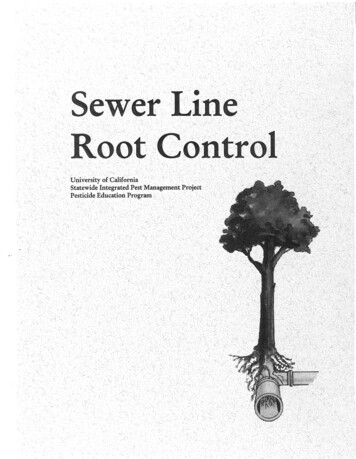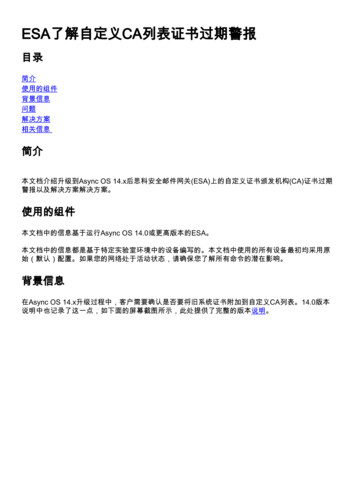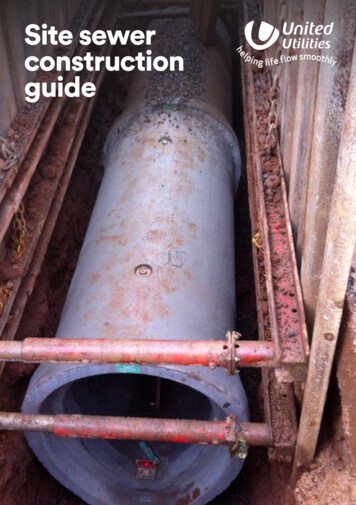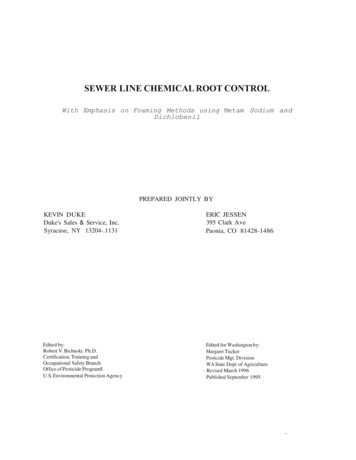
Transcription
SEWER LINE CHEMICAL ROOT CONTROLWith Emphasis on Foaming Methods using Metam Sodium andDichlobenilPREPARED JOINTLY BYKEVIN DUKEDuke's Sales & Service, Inc.Syracuse, NY 13204-.1131Edited by:Robert V. Bicbuski. Ph.D.Certification, Training andOccupational Safety BranchOffice of Pesticide Program U.S. Environmental Protection AgencyERIC JESSEN395 Clark AvePaonia, CO 81428-1486Edited for Washington by:Margaret TuckerPesticide Mgt. DivisionWA State Dept of Agriculture·· Revised March 1996Published September 1995.
.PREFACESewer line root control is a matter of using the right technologies. To be successful, thetechnology must be effective and must not adversely affect people or the environment.The purpose of this training manual is to provide a sound foundation for studying thetechnical aspects of sewer line root control with emphases on the safe use and application ofchemical products, especially those containing .metam-sodium, a restricted use pesticide.On March 1, 1996, metam-sodium for sewer root control was reclassified as a restricted usepesticide. The U.S. Environmental Protection Agency (EPA), which is responsible forregistration of pesticide products, made this decision because of concerns that metam-sodiumproducts used in sewers for root control could adversely affect the health of humans, domesticanimals and the environment. This action means that metam-sodium root control products mayonly be purchased by certified pesticide applicators and applied ·only by or under thesupervision of such certified applicators. In addition, Washington State requires that anypesticide applied commercially or through the use of power equipment, requires a pesticidelicense. People desiring certification status must apply to the Washington State Department ofAgriculture(WSDA).In order to obtain a license in the Sewer Root Control category, individuals must pass a Laws& Safety exam, the Sewer Root Control exam and pay the applicable fee (based on the type oflicense). This manual is the study material for the latter exam; the study manual for the Laws &Safety exam is available through Washington State University (WSU).Contact WSU'sBulletin Office at (509) 335-2857 and ask for the manual, Washington Pesticide Laws andSafety (MISC0056). Order forms for the manual are also available from WSDA by calling(360) 902-2020.This manual is a valuable source of information for people preparing for certification. Eachchapter covers material considered essential to the proper understanding and implementationof root control involving chemicals such as metam-sodium. Also included is basicinformation and guidelines to assist the applicator in solving practical problems involvingroot control.This manual was adopted from a federal manual by the Washington State Department ofAgriculture. Please communicate any suggestions revision to: ESDA/Certification &Training/Attention: Market Tucker/P.O. Box 42589/Olympia, WA 98504-2589. Thank you!
TABLE OF CONTENTSPrefaceChapter 1. Pests, Pesticides and Regulations ------------------1-2PestsPesticidesChapter2. Roots in Sewers and Treatment of Roots in Sewers--- 3-12Root GrowthNon-Chemical Methods of RootControl Chemical Methods of RootControl Identifying Lines with RootProblemsChapter 3. Metam-Sodium --------------------------13-16Root Treatment FormulationHistory of UseDichlobenilChapter 4. Cautious Metam-Sodium Use near Treatment Plants -17 - 34Wastewater Treatment Facilities – an OverviewVariables in the Wastewater TreatmentFacility that Influence Root ControlApplicationEffects of Chemical Root Control on WastewaterTreatment Plant Processes.Chapter 5. Application of Metam-Sodium Root Control Chemicals -35 - 54Application EquipmentFoaming Techniques for ApplyingMetam-Sodium Root Control ChemicalsCleaning of Pesticide SpillsCalculating the Amount of Chemical RequiredApplication Check-ListDosage of Product to a Particular SystemMetam-Sodium Root Control Chemical- ApplicationDetermining Effectiveness of Metam-Sodium RootControl TreatmentsGlossary ----------------------55-61
CHAPTER1PESTS, PESTICIDES AND REGULATIONSLearning ObjectivesAfter you complete your study of this unit, you should be able to: Describe what a pest is and name the different types of pests. Explain what a pesticide is.Pest ManagementThis chapter is intended to provide the applicator with a general background in the safe use of pesticides.Although this manual focuses on the use of sewer line root control products which contain metam-sodiumas an active ingredient, knowledge of pesticides, what they are and how to handle them safely is somethingall collection system applicators should be aware of. For example, a product that is an 11degreaser11may, in its marketing material, claim to kill or control roots. Because of that claim, the product isclassified as a 11pesticide” and is subject to the regulations governing pesticides. All pesticides offered forsale or use in the United States and its territories must be registered with the U.S. Environmental ProtectionAgency (EPA). In addition, products used in Washington State must be registered with WSDA ·PestsA pest is anything that: competes with humans, domestic animals, or desirable plants for food, feed or water, injures humans, animals, desirable plants, structures or possessions, spreads disease to humans, domestic animals, wildlife or desirable plants, and annoys humans or domestic animals.Types of pests include: Insects such as roaches, termites, beetles, mosquitoes, fleas and caterpillars, Insect-like organisms, such as ticks, spiders and scorpions, Mollusks such as snails, slugs, oysters, clams and shipworms Weeds, which are any plants growing where they are not wanted, such as mosses, algae, dandelionsand any plant part such as root intrusions into wastewater collection systems, Plant disease pathogens, such as fungi, bacteria and viruses, and Vertebrates, such as rats, mice, other rodents, birds, reptiles, and fish.I
.'PesticidesA pesticide is defined as any substance or mixture of substances intended for preventing,destroying, repelling, or mitigating any pest, and any substance or mixture of substancesintended for use as a plant regulator, defoliant, or desiccant. The wise use of pesticides cancontribute significantly to the health, welfare and quality of human life. However, improper useof pesticides can be a threat to human health and environmental quality.For a more detailed discussion of pesticides and the regulations governing them, refer toWSU's Washington Pesticide Laws & Safety manual (MISC0056). This is the study manualfor the required Laws & Safety exam.Test Your KnowledgeQ. When may tree roots be considered a pest?A. When they become pests when they affect humans' property and well-being especially when they invadeand damage sewer pipes in search of food and water.Q. Name several different types of pests.A. Some insects, other invertebrate organisms such as spiders and ticks, plant diseases, weeds, and vertebratessuch as mice and rats.Q. What is a pesticide?A. A pesticide is any substance or mixture of substances intended to prevent, destroy, repel or mitigateany pest, or for use as a plant regulator defoliant or desiccant.
CHAPTER 2ROOTS IN SEWERSLearning ObjectivesAfter you complete your study of this unit you should beable to: Determine the two different types of root systems and which isassociated with sewer problems. Be familiar with factors around sewer pipes that influence root growth. Identify the two types of root structures in sewer lines. Describe at least three non-chemical methods of root control. Name at least four different chemical control methods other than metam-sodium. Explain the differences between contact and systemic herbicides and betweenselective and non-selective herbicides. Describe three methods used to identify which sewer lines have root problems.Root Related Sewer ProblemsThe intrusion of roots into sewers is probably the most destructive problem encountered in awastewater collection systemRoot relatedinclude:sewerproblems Sewer stoppages and overflows, Structural damage caused by growing roots Formation of septic pools behind root masses which generate hydrogen sulfide,other gases and odors, Reduction in hydraulic capacity, and loss of self-scouring velocities, Infiltration where the pipe is seasonally under the water tableSewer stoppages and overflows are the way that most municipalities and homeowners find outabout their root problems. Structural damage, on the other hand usually goes unnoticed untilthe damage is determined through television probing. In the long run, structural damage isprobably more costly than sewer stoppages.Sewers are underground, so root problems are not noticed until backups or overflows occur.Effective use of early, preventive root control can avoid costly and permanent structuraldamage. However, many municipalities are unlikely to fund a preventive root control programuntil a known problem alerts officials to the need for control.
. Root GrowthRoots have three basic functions: 1) they anchor the plant and hold it upright, 2) they store foodfor the plant, 3) and they absorb and conduct water and nutrients.Roots are tenacious and long-lived. The top of a plant is more dependent on the root systemfor survival than vice-versa. A plant can regenerate after it has been topped but cannot survivethe loss of its root system. A willow tree root system can survive for many years after the tophas been removed and will continually try sending up new shoots through the stump or exposedroots. The root systems of some grasses of the American Great Plains are thought to haveremained alive for thousands of years. Just how far roots will grow in search of moisture andnutrients is uncertain. In the Rocky Mountains in Colorado, live tree roots have been foundpenetrating a pipe in the Moffet tunnel, 2500 feet from the nearest tree.Root Systems: Plants may have either a fibrous root system or tap root system. Plants withfibrous root systems, such as garden plants and grasses, occupy the upper layers of soil andextend outward. They are not normally associated with sewer problems.·Tap root systems. Examples of plants with tap root systems are the trees and woody plants.The primary root of the plant grows directly downward into the soil. Tap root systems are welladapted to deep soils and soils where the water table is relatively low.Branches, orsecondary roots, grow laterally from the primary root. Secondary root structures can growseveral inches in diameter, and if they invade sewer pipes can exert enough pressure to spreadpipe joints and break pipe.Feeder roots are fine, hair like roots that may develop into secondary roots. The surfaces offeeder roots contain microscopic structures called root hairs. Root hairs greatly increase thetotal surface area available to absorb nutrients and water.The leading tip of a root shoot, the meristem, “Senses” minute differences in nutrient andmoisture levels and grows toward them. The ability to detect these differences enables the root tolocate a sewer pipe. Temperature variances between waste water flow within a pipe andsurrounding soil may cause condensation to form on the pipe. Also, loose pipe joints, cracks, andpipe porosity allow high nutrient content water to seep from the pipe into the surrounding soil.This type of environment attracts and encourages root growth.·Factors Affecting Root Growth: A number of different soil conditions around sewer lines influenceroot growth. Back fill used during sewer construction may provide more favorable soil than the ·existing, undisturbed soil Water table levels will fluctuate with seasonal changes. During drierseasons, the water table drops and tree roots will grow deeper in search of moisture. The tendencyof roots to grow towards moisture is called hydrotropism. Sewer lines above the water table willdraw roots in that direction. During colder seasons, especially where ground frost occurs, thewarmer soil temperatures surrounding the sewer pipe may also cause the roots to grow in thatdirection. Moisture and warm temperatures surrounding a sewer pipe create an excellentenvironment for root growth. If the moisture level drops below a certain point, roots will begin towilt.
Microscopic openings permit hair-like structures to penetrate pipe joints, cracks, connections,or any other opening. Heavy secondary root structures may follow a sewer pipe for manyfeet, exploiting each opportunity to penetrate pipe joints.Roots thrive in sewer pipes, a perfect hydroponic environment. Roots are suspended in awell ventilated, oxygen rich environment with a plentiful supply of water and nutrients.Generally, root growth is greatest in fall, winter, and spring before leafing. At this time rootsare either storing or distributing nutrients. Root growth is less active in the late spring andsummer when the above ground portion of the tree is growing. Little is known about thegrowth rate of tree roots.Roots of most trees cannot grow or survive if constantly submerged in water. Therefore, rootsgenerally do not cause problems in sewers that are located below a permanent water table.With adequate water, available roots need not expend energy trying to penetrate the watertable and sewer pipes. However, if the water table fluctuates, or if porous soil profiles permitrapid downward movement of rain water, roots can be found in saturated soil and can be amajor cause of sewer infiltration. In this case, tree roots suspended in the atmosphere of thesewer can carry on metabolic activity while the woody, submerged portion of the root systemserves as a pipeline for plant nutrients.Roots must always grow because parts of the root system are constantly dying. If a rootsystem stopped growing, the plant would die. When the nutrients or moisture in an area of soilis depleted, feeder roots die. Secondary roots elongate or stop growing, depending on theavailability of additional nutrients. In time, bacteria in the soil break down the dead roottissue, helping to replenish the depleted nutrients.Roots in the Sewer Environment:In urban environments, finding good sources of nutrients for tree roots may be difficult.Expanses of concrete and asphalt, removal of leaves and other organic debris from lawns andstorm sewers, and draining away surface water all cause roots to seek nutrition at greaterdepths. Some roots may follow building sewers well beyond the tree's drip line to the mainline sewer.Two types of root structures found in sewer lines are known as veil and tail. The veil rootstructure occurs in lines with steady flows, such as interceptor pipe and other lines withconstant flow. The roots will penetrate pipe at the top or sides and hang from the uppersurface, like a curtain, touching the flow. Live roots are seldom found below the water line.The roots will rake the flow accumulating solids and debris. Grease and other organicmaterials will also accumulate. Eventually the root mass and accumulated material will causea stoppage of flow and gasses may develop.The tail root structure occurs in sewers that have very low or intermittent flow, such as insmall diameter collector sewers, building sewers, and storm drains. The tail root structurelooks like a horse's tail. The roots will grow into the pipe from the top, bottom, or sides, andcontinue to grow downstream filling the pipe. Tail root structures over 20 feet long have beenremoved from sewers. Such root structures may appear as solid tubes of tree root, possiblywith a slightly flattened area along the bottom where submergence in sewer flows prevent rootgrowth.
Roots that enter the sewers or are visible during a television inspection represent only asmall percentage of total root structures in the vicinity of the sewer. Roots girdling the pipe onthe outside are responsible for pipe damage as they swell inside joints and cracks.Non-Chemical Methods of Root ControlChemical, as well as several non-chemical methods of sewer line root control are available tothe root control expert and the public works officials. Although non-chemical methodsgenerally do not provide the same level of results as chemical methods, they have an importantplace in sewer maintenance. For example, mechanical methods are best for opening pluggedsewers and for removing roots from sewers that are at imminent risk of plugging. In somecases, chemical control methods should not be used, especially when near treatment plants ordue to other environmental or safety considerations. Pipe re-lining, grouting and sealing mayalso deter intrusion by roots. Municipal planners may discourage future root problems bydiscriminate selection and planting of trees in the proximity of proposed sewer lines. Asuccessful line root control program will integrate cultural, physical, mechanical, and chemicalroot control methods.Cultural Control. Cultural control of roots in sewers includes routine management practicesthat can prevent tree roots from invading sewer lines. Cultural control must be implementedbefore roots have a chance to become a problem. Two major cultural methods are: 1) carefulinstallation and inspection of sewer lines during construction, and 2) control of the selection oftree species and planting sites. Sewer connections with air-tight joints and seams, will make itdifficult for roots to penetrate. Municipalities should carefully inspect connections whereplumbers join building laterals to the main line sewer. Also, homeowners should be advised ofthe potential for future root problems and should be discouraged from planting deep rooted orfast growing trees near sewer lines. Willow trees, in particular, have adventurous and thirstyroots. Unfortunately, when a sewer root problem is detected, it is too late for cultural control.Physical Control. Physical pest control relies on devices or procedures which physicallyseparate the pest from the target area. A mosquito net is a physical pest control method.Physical control of sewer line roots involves isolating the environment of the sewer pipe fromthe roots around or near the sewer pipe. Three examples of physical control are: 1) treeremoval, 2) pipe replacement, and 3) pipe re lining.Tree removal: This method works best when removing a single troublesome tree such as awillow whose roots have invaded pipes. Unfortunately, it is difficult to convince homeownersalong "Shady Lane" that the municipality's public works department should remove their trees inthe vicinity of sewer lines. This would not only be expensive but would not guarantee removalof the root problems. Roots may survive long after the death of the above ground part of thetree, necessitating the use of mechanical or chemical controls for some time afterward. Fortree removal to be most effective, the stump should be pulled or chemically treated with a basalapplication herbicide.
Pipe replacement involves removing old, defective sewers and replacing them with newsewers. As discussed above, the new sewers must have air-tight joints and properly installedconnections in order to prevent the roots from becoming a problem Pipe replacement correctsstructural defects as well as root problems. There are four major disadvantages to pipereplacement: 1) cost, 2) disruption of traffic and property, 3) roots can still enter through buildingsewers, and 4) the destruction of trees planted in the vicinity of the trench line. If the pipe is indanger of collapsing, or is in a state of structural failure, pipe replacement may be the bestmethod of control. Pipe replacement is not warranted when the pipe is in sound structuralcondition.Pipe lining includes various technologies for rehabilitating sewer pipe. Root must bechemically or mechanically removed prior to installation. One method, "Slip-lining" involvespulling a seamless pipe through the existing sewer and digging only where building lateralsrequire connecting. Another method, "Cured-In-Place" lining involves inflating and curing a sockor plastic tube that conforms to the shape of the pipe. Robotic devices are then used to cutbuilding connections into the liner.Advantages of pipe lining are: 1) addresses infiltration problems and some structural defects, 2)is less disruptive than pipe replacement, and 3) promises long-term control against root regrowththrough joints. Disadvantages of pipe lining are: 1) it is often more costly than replacement, and2) roots can still re-enter the main-line sewer through building laterals. Even after relining themain-line sewer, chemical control may be required to prevent roots from penetrating the mainline sewer through service connections.Mechanical Control: Mechanical control is the most common method of root control and themost important non-chemical method for applicators to understand: Mechanical control involvesthe use of tools or other devices which cut and remove roots from sewers.Drill machines, also called coil rodders, are either hand or power-driven, spring-like,flexible steel cables which turn augers or blades within the sewer. They are most often used byplumbers to relieve blockages in house-lines or other small diameter sewers. They are seldomused in main-line sewers.Rodding machines, are flexible steel rods with attached rotating blade cutters, augers, orcorkscrews. Rodding machines are most effective in small diameter sewers up to 12".Jetters are also known as flushers, flush trucks, jet rodders, jet trucks, and hydraulic sewercleaners. Jetters consist of a high pressure water pump, water tank, hose reel, and 1/2" to 1"sewer cleaning hose. Orifices in the rear of the nozzle propel the hose through the sewer. Thenozzle blasts through obstructions. As the hose and nozzle is retrieved, debris is hydraulicallyflushed back to the insertion manhole for removal. Jetters can also be equipped with root cutterswhich use the force of water to spin blades. Unfortunately, root cutters can easily get stuck inthe sewer, especially where there are protruding taps or other structural defects. Bound cutterscan only be removed by digging them out.·.Winches, also called drag machines or bucket machines, are large; engine-driven winches·which pull buckets, brushes, or porcupine-like scrapers through the sewer. Special tools aredesigned to cut
roots. Winches are most often used on large diameter sewers which cannot be cleanedefficiently with jetters. Winches are used in heavy cleaning to remove large volumes of solids.The main advantage of mechanical control is that it is the only method of relieving a rootblockage. Chemicals are ineffective and dangerous when used in plugged or surchargingsewers. Sewer stoppage is an emergency situation and the municipality should have some typeof mechanical control device for correcting such problems.The main disadvantage of mechanical control is that it provides no residual control or longterm effectiveness. Roots respond to injury by producing a hormone, abscisic acid, whichhastens and thickens regrowth. Root masses grow back heavier each time they are cut. Taproots continue to grow in diameter and, in time, place additional stress on sewer pipes. Goodresults are obtained if the roots are cut flush with the joints; however, offset joints and cut-inlaterals can prevent the use of full gauge cleaning tools.Mechanical control is often used in conjunction with chemical control. One example of this iswhen sewer lines are being prepared for rehabilitation with pipe-lining and grouting.Chemical Root Control: Pesticides are the fastest way to control pests. Choosing the bestchemical for the job is important. Chemicals used to control weeds are called herbicides.They kill plants by contact or systemic action. A contact herbicide has a localized effect andkills only the plant parts which the chemical comes in contact With. Systemic herbicides areabsorbed by roots or foliage and carried throughout the plant. Contact herbicides result inquick die-back. Systemics take longer, two weeks or more, to provide the desired results.Metam-sodium is a contact herbicide.Herbicide activity is either selective or non-selective. Selective herbicides kill certain types ofweeds such as broadleaf grassy plants. They are used to reduce unwanted weeds withoutharming desirable plants. Non selective herbicides kill all plants present if applied at anadequate rate. They are used where no plant growth is wanted. Metam-sodium is a non-selectiveherbicide.Many chemicals have been tried for root control. The more common ones used today arediscussed below.Trifluralin. Brand Names: Treflan, Bio-Barrier.Fabric or rubber impregnated with trifluralin pellets is a relatively new concept in sewer lineroot control. The impregnated fabric is placed between the sewer pipe and trees at the timeof sewer installation. The porous fabric allows water to pass through. The trifluralin pelletsare time-released, with manufacturer’s claims that the active ingredient leaches only a fewinches before being trapped by soil particles. Impregnated rubber is used for joint gaskets.Three advantages of this method are: 1) root control is long-lasting without a need for retreatments 2) Pesticides are not directly introduced into the sewer collection system, and 3)environmental risk is minimized.
IThe main disadvantage of this method is that it cannot be employed economically after aproblem occurs. In addition, it is an unnecessary economic expense if the pipeline is adequatelyinstalled in the first place. Modem pipeline installation, if done correctly, can adequately deterroot penetration.Copper Products: Synonyms: Copper Sulfate, Bluestone. Numerous brand namesAlthough small amounts of copper are required by plants for normal growth, excessiveamounts of copper will cause leaf damage and could result in the death of the tree. Copper is aheavy metal which may not be removed by the normal treatment process. Not only can it betoxic to the treatment plant's microbes but it exits the treatment plant as a pollutant in both theeffluent and the biomass (sludge), thus becoming a potential environmental contaminate.Copper Sulfate 1ms been used for many years for root control in sewers and as an algaecide.Some studies have shown that high concentrations of copper sulfate cause systemic injurywithout completely killing the roots. Nevertheless, copper sulfate products are still inwidespread use by many plumbers and homeowners as a "pour down" application forcontrolling roots in building sewers. Copper sulfate is believed to be a relatively safe materialto handle, posing little health risk to the applicator.The use of copper products may not be permitted in some states. Check with local authoritiesbefore using.Metam-Sodium and DichlobenilMetam-sodium and dichlobenil have been used together as a root control product in sewers forapproximately 25 years. Metam-sodium is a fumigant. It breaks down into a gas,methylisothiocyanate (MITC), which kills the plant roots. It is a contact, non-systemic pesticide.Metam-sodium is used in combination with dichlobenil which is an effective growth inhibitor.These two pesticides were originally applied together by spray or soak methods. Soakingentailed plugging the pipe, filling it with the chemical for a period of time, allowing thechemicals to penetrate any blockages as well as soaking out cracks and joints to kill further upthe root system. Spraying involved spraying the interior of the pipe with the chemical solution.Because of the large doses of chemical used and their apparent threat to treatment facilities,the soak and spray methods are no longer recommended.Current methodology uses metam-sodium products as dry foam (similar to shaving cream).Specialized foam generating equipment is used to produce the foam which is then applied tothe interior of the pipe. Application is made through a hose which is inserted the length of pipeto be treated. While the hose is being retracted, foam is pumped through the end filling the pipewith foam. As the foam collapses (over a period of 1 hour or more) it has a tendency to adhereto the pipe and root surfaces.
Any product that does not adhere to the roots and pipe walls enters the wastewater in the pipeand is carried to the treatment facility. The dilution of the product in the wastewater, andthe rapid breakdown (fuming oft) of the metam-sodium, allows a safety margin for thetreatment plant.Once the roots have been killed (within hours of application), bacteria and other microbes in the sewerbegin to breakdown the dead tissue. Total decomposition of the roots may take several months to ayear or more. The decomposed organic matter enters the wastewater stream and is carried to thetreatment plant for disposal. Root regrowth will start in a couple of years which may necessitateretreatment at 3 to 5 year intervals.Identifying Which Lines Have Root ProblemsPest identification is usually the first and most important step in a pesticide control program Insewer line chemical root control pest identification is not a issue because it does not matterwhich species of tree is producing the nuisance roots. All roots in sewers are pests - there areno beneficial species.In sewer line chemical root confronted sewer applicator is confronted with the problem ofdetermining which sewer lines have been infiltrated by roots. Several indicators are availablefor determining which collection lines have root penetration:(1) Maintenance histories. Maintenance records will indicate sewer lines which haveexperienced a stoppage and the cause of stoppage.(2) Sewer line television reports. These provide accurate evidence of a rootproblem.(3) Commonalties in root prone areas. Generally, sewer lines in the same area, which wereinstalled at the same time with similar tree-planting patterns near sewers, will experiencesimilar root problems.Conditions which increase the likelihood of root problems in a particular sewersection are: Sewers located near other sew
Sewer line root control is a matter of using the right technologies. To be successful, the technology must be effective and must not adversely affect people or the environment. The purpose of this training manual is to provide a sound foundation for studying the
